
The Lawrence Berkeley National Laboratory 75th Anniversary Exhibit
On display now in the Building 50 Lobby
The Founding of a Laboratory and Scientific Legacy
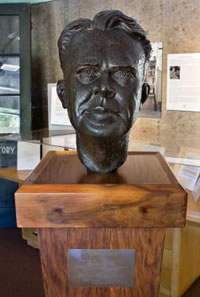
In the summer of 1928, Ernest Orlando Lawrence, a 27-year-old physics professor from Yale University, joined the faculty at UC Berkeley. He was the prized recruit of Robert Gordon Sproul, secretary to the UC Board of Regents and soon-to-be UC President, as part of a major effort to elevate UC’s physics department to the same lofty stature of its renowned chemistry department. After three years of working out of Room 329 in Le Conte Hall, where he invented the “cyclotron,” the circular particle accelerator that would eventually win him a Nobel Prize in physics, Lawrence needed a much larger space to accommodate his proposed 27-inch cyclotron. He also needed a much firmer floor. A key component of the 27-inch cyclotron was to be an 80-ton magnet, which Lawrence obtained from the Federal Telegraph Company. The magnet was originally built to power a transatlantic radio link in World War I but had since become surplus. Working with Leonard Fuller, a UC Berkeley electrical engineer who also happened to be a Federal Telegraph Company vice-president, Lawrence received the magnet as a donation. He was less successful getting free electrical power from PG&E.
The perfect new home for Lawrence’s expanding research program was a two-story, clapboard-sided wooden building, which stood adjacent to Le Conte Hall. It had been the site of the Civil Engineering Testing Laboratory (CETL) but was now empty. Constructed in 1902, the CETL featured a concrete floor strong enough to support the 80-ton magnet. On August 26, 1931, President Sproul awarded Lawrence full use of the CETL, which Lawrence promptly renamed the "Radiation Laboratory," soon known simply as “The Rad Lab,” the precursor to today’s Lawrence Berkeley National Laboratory. For his invention of the cyclotron, Lawrence won the 1939 Nobel Prize in physics. Because of the war in Europe, the ceremony was held in Berkeley, rather than in Stockholm. One year later, construction began on Lawrence’s 184-inch cyclotron. Far too large to be located on the UC Berkeley campus, this machine was built in the hills overlooking the campus, the location of Berkeley Lab today.

Portal to a New Science
The front entrance door to the Civil Engineering Testing Laboratory that became Ernest Lawrence’s Rad Lab in 1931. According to legend, when the old building was being torn down in 1959, Melvin Calvin, the future Nobel laureate chemist, salvaged the door for posterity.
The Early Cyclotrons
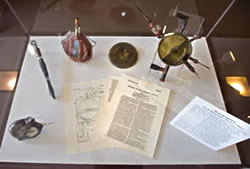
Modern physics is based on the ability of scientists to venture inside the atom and explore the elementary particles of force and matter. This requires energy that physicists obtain through particle accelerators. Ernest O. Lawrence opened the door to modern physics with the invention of the cyclotron, which featured a unique circular design that made possible the production of high energies in a machine relatively compact in size. A cyclotron is composed of two semicircular electrodes encased in a closed vacuum chamber and sandwiched between the poles of a circular electromagnet. An electric field fills the gap between the electrodes. Particles moving across this gap are given an electrical push forward. The magnet bends the path of the particles so that they travel in a circle. This means that the particles keep crossing through the same accelerating gap over and over again, gaining speed and energy with each crossing. Lawrence’s first crude cyclotron was constructed in the spring of 1930, a pie-shaped concoction of glass, sealing wax, and bronze. The first working model was built later that fall. It measured five-inches in diameter and on January 2, 1931, it was successfully used to boost hydrogen ions (protons) to an energy of 80,000 electron volts.
How Does A Cyclotron Work?
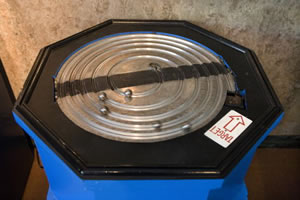
The term “cyclotron” was originally laboratory slang for “magnetic resonance accelerator.” A cyclotron is composed of two semicircular electrodes called “dees” because they are shaped like the letter “D.” These dees are encased inside a vacuum chamber that is exposed to a powerful external magnetic field. The application of a voltage to the two dees creates an electric field in the gap between them. When ions (charged particles) are introduced into the center of the vacuum chamber, the magnetic field causes them to begin to move in a circular path. As the ions cross the gap between the dees and they are given an energy kick that causes them to accelerate. The ions cross this accelerating gap twice during each orbit. Because the strength of magnetic field never changes, the orbit of the ions widens each time they gain energy. The accelerating ions continue to spiral from the cyclotron chamber’s center until they reach their peak energy at the chamber’s outer edge. At that point, the energized ions are drawn out of the chamber by an oppositely charged extractor and formed into a target-bombarding beam. This demo model in which steel marbles are used to show how ions are accelerated in a cyclotron is the same one used by Ernest Lawrence in the display film.
A New Science, A New Kind of Medical Treatment
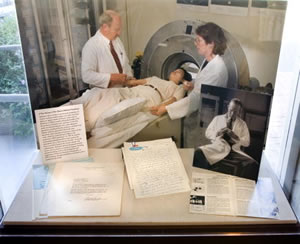
Berkeley Lab is credited with being the birthplace of nuclear medicine and the father was John Lawrence (photo at right), brother of Ernest. John came to Berkeley in 1935 to conduct biomedical studies with the products of Ernest’s new cyclotron. In his first study, he injected leukemic mice with radioactive phosphorus produced by the cyclotron, and then went fishing; when he returned he found the mice improved. John Lawrence presented a report on this work, which he wrote during his flight to the conference (TWA stationery.) In 1937 he used the radioisotope phosphorus-32 to treat a patient for polycythemia vera, a bone marrow disorder. It was the first successful treatment of a human disease with radioisotopes. Berkeley Lab has also gained national renown for its advances in medical imaging, including ground-breaking work in the development and application of Positron-Emission Tomography, or PET scanning, (background photo) commonly used in medical centers today.
The Bubble Chamber
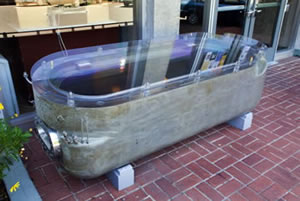
Fill a chamber with superheated liquid: the temperature is above the boiling point, but it hasn't boiled yet because it hasn't been disturbed. Now shoot charged particles through it; the liquid boils behind them, leaving trails of tiny bubbles. Put the whole thing in a strong magnetic field that forces the particles to curve, their direction and turn radius depending on their charge and mass. Photograph the curving trails of bubbles and look for particles you've never seen before. That's what Berkeley Lab researchers did with Nobel-Prize-winning success at the Bevatron in the 1950s and 60s, using bubble chambers like this giant steel bathtub designed by Luis Alvarez, which was filled with superheated liquid hydrogen.
Finding the Key to Photosynthesis
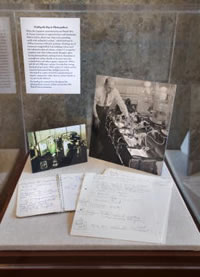
When the Japanese surrendered to end World War II, Ernest Lawrence is reputed to have told biochemist Melvin Calvin, that it was “time to do something useful with radioactive carbon,” which had been discovered in 1940 at Lawrence’s 60-inch cyclotron. Working out of Lawrence’s original Rad Lab, building, Calvin used the radioactive form of carbon, carbon-14, to map the complete route that carbon travels through a plant during photosynthesis, starting from its absorption as atmospheric carbon dioxide to its conversion into carbohydrates and other organic compounds. With a half-life of 5,700 years, carbon-14 is ideal for tracing biochemical processes. With carbon-14, Calvin and his research team proved that sunlight acts on the chlorophyll in a plant to fuel the manufacturing of organic compounds, rather than on carbon dioxide as was previously believed. For leading the research that deciphered the photosynthetic process, Calvin received the 1961 Nobel Prize in chemistry.
The First Radiation Symbol
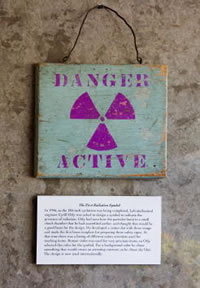
In 1946, as the 184-inch cyclotron was being completed, Lab mechanical engineer Cyrill Orly was asked to design a symbol to indicate the presence of radiation. Orly had seen how the particles burst in a small cloud chamber that he had assembled earlier, and thought that would be a good basis for the design. He developed a center dot with three wings and made the first brass template for preparing these safety signs. At that time there was a listing of different colors scientists used for marking items. Roman violet was used for very precious items, so Orly selected this color for the symbol. For a background color he chose something that would create an arresting contrast, so he chose sky blue. The design is now used internationally.
Particle Detectors
In modern physics, large accelerators and colliders, the descendants of Lawrence's original cyclotron invention, are the first step in the experimental process. The accelerator creates a high energy beam which can be used to "split" particles into their sub-constituents, and create reactions in which new forms of matter are created. The second step is the use of detectors to sift through the debris of these reactions and identify those of interest.
On display are components of a Silicon Vertex Detector (SVX), an extremely high-resolution instrument which enables scientists to identify and track the trajectories of subatomic particles that emerge out of collisions between protons and antiprotons. The SVX was installed in the Collider Detector at Fermilab (CDF) at the Tevatron collider in 1992. SVX was able to resolve, in detail, the region directly surrounding the interaction point at CDF and identify particles which traveled only a fraction of a millimeter before decaying. It played a key role in the discovery of the top quark, announced in 1995. Descendants of the SVX will be part of all the detector arrays at the forthcoming Large Hadronic Collider (LHC), the world’s most powerful accelerator/collider now under construction on the outskirts of Geneva, Switzerland.
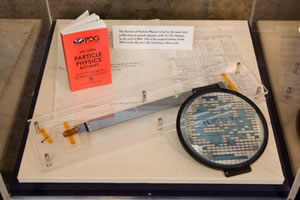
Shown in the display are silicon microchips (round ring) remaining from a wafer which was sawed apart. The microchip here is called the "SVX-Chip" and hundreds of these were used at heart of the CDF detector. The chip, invented by LBNL Engineer Stuart Kleinfelder, measured and processed the signals from the particles as they crossed the detector. The SVX-Chip was designed to operate unaffected by the extremely high radiation levels present near the particle collision point. Also shown is a detector "ladder" (long rectangular structure) which holds SVX-Chips and three crystals of high resistivity silicon, which respond electrically to the passage of particles. The crystals and the SVX chips are interconnected by about one thousand hair-thin aluminium wires, barely visible to the naked eye. LBNL physicists assembled about 100 of these ladders for CDF. The new arrays, such as ATLAS, at the CERN LHC, contain thousands of the ladder-like elements.
The Time Projection Chamber
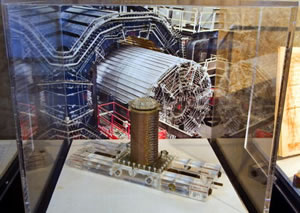
A prototype of a Time Projection Chamber (TPC), a barrel-shaped detector so-named because it identifies particles on the basis of the time it takes their signal to move through a gas. TPCs can detect and sift through thousands of particles simultaneously. Invented in 1974, they have become and remain the workhorse of modern particle physics experiments. A TPC serves as the heart of STAR, a 1,200 ton detector system at RHIC, the Relativistic Heavy Collider, shown in the photograph, at Brookhaven National Laboratory. STAR is designed to explore an exotic form of matter called a quark gluon plasma, which briefly existed in the first few microseconds after the Big Bang and set the stage for the combinations of particles that make up our universe today.
Adding New Elements to the Periodic Table
There have been fourteen atomic elements discovered here at Berkeley Lab, including element 106, which was named seaborgium for the Nobel laureate Glenn Seaborg, a pioneer in studying the chemistry of the transuranium elements – those beyond uranium, the last natural element on the Periodic Table.
Plutonium in a Cigar Box?
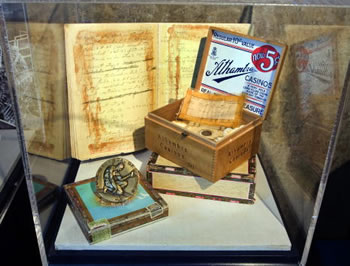
When Glenn Seaborg discovered atomic element 94, he named it “plutonium” after Pluto, our solar system’s ninth planet, because it came after neptunium on the Periodic Table, named for Neptune, the eighth planet from the sun. Plutonium should have been assigned the symbol “Pl,” but, as a prank, Seaborg gave it the symbol “Pu” as in “pee-yew.” All information pertaining to plutonium was classified during World War II, so Seaborg could never refer to the element by name, not even in his notebooks, hence the “sample A” in red letters. Despite its toxic reputation, plutonium radiates alpha particles, which do not have enough energy to penetrate skin or clothing, let alone cardboard. This meant Seaborg could carry samples of his discovery in one of the many old cigar boxes he’d gotten from the great UC Berkeley chemist, Gilbert N. Lewis, an inveterate cigar smoker for whom Seaborg had once served as a research assistant. Seaborg shared the 1951 Nobel Prize in chemistry with fellow Berkeley Lab scientist Edwin McMillan, for their discoveries of neptunium and plutonium. His many other awards include the National Medal of Science (shown here) in 1991.
A SASSY Way to Discover New Elements
When a beam of heavy ions bombards a target, fragments of heavy ions, called “recoil products” can be produced. This device, called a Small Angle Separator System, or SASSY, made use of a dilute gas to separate heavy ion recoil fragments from the beam of heavy ions that produced them. It was mounted in the now decommissioned Super Heavy Ion Linear Accelerator, or SuperHILAC, and played a key role in the discovery of several transuranium elements, including Seaborgium, element 106.
The Greening of the Laboratory

Since the 1970s, Berkeley Lab has been a leader in the development of “green” technologies that have saved our nation billions of dollars in energy costs over the years. One of the most successful programs has been energy-efficient “smart windows,” that allow light in but block too much heat entering in the summer or escaping in winter. The lab also designed software that architects and planners can use to build more energy efficient buildings. The building in this picture was designed with the help of EnergyPlus, the successor to DOE-2, the building energy simulation software that has saved billions of dollars in energy costs. Another success has been low NOx burners, which significantly reduce the emission of nitrogen oxide gases from the combustion of natural gas. Nitrogen oxides generate photochemical smog and haze, and their reduction is considered a major priority for air quality.
New Tools for Data Analysis and Collaboration
Berkeley Lab has fostered many innovations in scientific computing and networking. In the 1950s, Luis W. Alvarez envisioned using electronic scanners and computers to read and analyze the photographic images traced by subatomic particles in his bubble chamber—something that had never been done before. Alvarez’ team developed the necessary electronic devices and wrote new computer programs, and by 1968 their Spiral Reader was analyzing 1.5 million particle “events” per year.
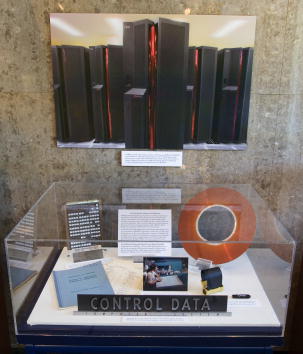
In 1974, the Lab’s CDC 6600 became the first online supercomputer when it was connected to ARPANET, the Internet’s predecessor. In 1986, when the Internet was on the verge of collapse from congestion, a Berkeley Lab researcher, Van Jacobson, co-developed the congestion control algorithms that allowed the Internet to keep growing. And in 1995, Jacobson and Steven McCanne developed MBone, the first successful software for multiparty audio and video conferencing over the Internet.
Today Berkeley Lab hosts the National Energy Research Scientific Computing Center (NERSC), which provides computational resources and services to more than 2000 scientists nationwide, and the Energy Sciences Network (ESnet), a high-speed network serving thousands of Department of Energy scientists and collaborators worldwide. NERSC’s newest supercomputer is Bassi, a 976-processor IBM p575 POWER5 system. Bassi has a theoretical peak performance of 7.4 trillion floating-point operations per second and has 100 trillion bytes of disk storage. The machine is named in honor of Laura Bassi, an eighteenth-century physicist and the first woman to officially teach at a European university (Bologna).
Semiautomatic Spiral Reader: This reader could analyze up to 150 bubble chamber events an hour (1968).
Nameplate from CDC 6600 serial number 9: This supercomputer, located at Berkeley Lab, was the first supercomputer connected to ARPANET (1974).
CDC 7600 module: A processing unit from the CDC 7600, which contained a central processing unit and a number of peripheral processing units. This 1971 supercomputer had a peak speed of 36 million floating-point operations per second.
The CDC 38500 tape cartridge (1976): This cartridge held 8 million bytes of data (left); the entire system held 16,384 cartridges. The magnetic disk (rear) stored 300 million bytes. Today’s pocket-sized USB flash drives contain up to 2 billion bytes.
How Does a Spark Chamber Work?

When an electrically charged particle passes through matter it knocks a few electrons loose from the atoms of the material. The electrons are free to wander around for a very short time before they get reattached to the atoms. If the material is a gas and we apply a high voltage across the gas while the electrons are free, a spark occurs at the point where the particle passed.
The chamber has a number of parallel Aluminum plates with Neon gas between them. Just above and below the chamber are scintillation counters. Each produces an electrical pulse whenever a charged particle passes through it. A coincidence circuit checks to see if there is a pulse from both counters at the same time. If thenre is, it means there is a good chance that a cosmic ray particle has just passed through the chamber. The circuit then tells the high voltage switch to turn on 10,000 volts between alternate Aluminum plates. Most of the time, a cosmic-ray muon has passed through the chamber.
This display was produced jointly by the Communications Department and the Creative Services Office (CSO).
Design and Installation: Marilee Bailey
Photography: Roy Kaltschmidt and the photo archives
Illustration and Poster Design: Cait Youngquist and Flavio Robles, Jr.
Text: Lynn Yarris
Research and Editorial: Pam Patterson
We are grateful to the reviewers for their invaluable suggestions, and to the Bancroft Library for its generous loan of historical documents.